- If at first the idea is not absurd, then there is no hope for it.
— Albert Einstein (1879–1955), German-born Physicist & Philosopher, Author of Out of My Later Years - Every time you meet somebody, you’re looking for a better and newer and bigger idea. You are open to ideas from anywhere.
–Jack Welch (b. 1935), American Business Executive & Author of Jack: Straight From The Gut and Winning .jpg) The man with a new idea is a crank until the idea succeeds.
The man with a new idea is a crank until the idea succeeds.
–Mark Twain (1835–1910), American Author & Humorist, Author of Adventures of Huckleberry Finn- The rewards in business go to the man who does something with an idea.
–William Benton (1900–73), American Publisher, Businessman, Politician - Try this for a week: Each morning, spring out of bed at the first hint of light and focus first on the new and wondrous things that are just waiting to reveal themselves that day. Let curiosity well up inside of you. Let your mind open up to new ideas. Forget that you already know everything.
–Donna Kinni (b. 1961), American Author - The creative person wants to be a know-it-all. He wants to know about all kinds of things: ancient history, nineteenth-century mathematics, current manufacturing techniques, flower arranging, and hog futures. Because he never knows when these ideas might come together to form a new idea. It may happen six minutes later or six months or six years down the road. But he has faith that it will happen.
–Carl Ally (1924–99), American Advertising Executive - When it comes to organizational imagination, everyone is a point of light, inwardly afire with excellent ideas for making our companies work smarter, faster, leaner, and better. But as business leaders, we too seldom tap into our most valuable resource—the brain trust of our employees—to discover new pathways of progress and profits.
–Charles Decker (1961–2012), American Publisher - Inventors and men of genius have almost always been regarded as fools at the beginning (and very often at the end) of their careers.
–Feodor Dostoyevsky (1821–81), Russian novelist, Author of Crime and Punishment - Ideas are like rabbits. You get a couple and learn how to handle them, and pretty soon you have a dozen.
–John Steinbeck (1902–68), American Novelist and author of Of Mice and Men .jpg) Keep on the lookout for novel ideas that others have used successfully. Your idea has to be original only in its adaptation to the problem you’re working on.
Keep on the lookout for novel ideas that others have used successfully. Your idea has to be original only in its adaptation to the problem you’re working on.
–Thomas Edison (1847–1931), American Inventor- No idea is so antiquated that it was not once modern. No idea is so modern that it will not someday be antiquated.
–Ellen Glasgow (1873–1945), American Novelist, Author of In This Our Life - To stay ahead, you must have your next idea waiting in the wings.
–Rosabeth Moss Kanter (b. 1942), American Academic, Author of Challenge of Organizational Change - Brainpower is now the greatest commodity we can contribute to the world. Democracy was never intended to be a breeding place for mediocrity. We must engage in the business of stimulating brainpower lest we fail in producing leaders of consequence. In a period of speed, space and hemispheric spasms we dare not treat new thoughts as if they were unwelcome relatives.
–Dean F. Berkley (1925–2009), American Academic - If you do not express your own original ideas, if you do not listen to your own being, you will have betrayed yourself. Also, you will have betrayed your community in failing to make your contribution.
–Rollo May (1909–94), American Psychologist - New ideas come from differences. They come from having different perspectives and juxtaposing different theories.
–Nicholas Negroponte (b. 1943), Greek-American Architect - Invention is the process by which a new idea is discovered or created. In contrast, innovation occurs when a new idea is adopted.
–Everett Rogers (1931–2004), American Sociologist - The best way to have a good idea is to have a lot of ideas.
–Linus Pauling (1901–94), American Scientist - Ideas are a capital that bears interest only in the hands of talent.
–Antoine de Rivarol (1753–1801), French Journalist - The power of an idea can be measured by the degree of resistance it attracts.
–David Yoho (b. 1946), American Business Consultant - An idea is salvation by imagination.
–Frank Lloyd Wright (1869–1959), American Architect and author of The Natural House .jpg) Daring ideas are like chessmen moved forward. They may be beaten, but they may start a winning game.
Daring ideas are like chessmen moved forward. They may be beaten, but they may start a winning game.
–Johann Wolfgang von Goethe (1749–1832), German Poet & Statesman, Author of Maxims and Reflections- If you can dream it, you can do it.
–Walt Disney (1901–66), American Entrepreneur & Entertainer - There is no prosperity, trade, art, city, or great material wealth of any kind, but if you trace it home, you will find it rooted in a thought of some individual man.
–Ralph Waldo Emerson (1803–82), American Philosopher and Essayist, Author of Self-Reliance - A great idea is usually original to more than one discoverer. Great ideas come when the world needs them. Great ideas surround the world’s ignorance and press for admission.
–Elizabeth Stuart Phelps (1844-1911), American Author of A Singular Life and other books - I’d climb into the car as it went down the assembly line and introduce myself. Then I’d ask for ideas.
–John Risk, American Automotive Engineer
Tag: Creativity
Ex-Google’s Marissa Mayer on Nine Principles of Innovation
The last decade’s most remarkable business story has been the rise of Google as a dominant force in computing. Whenever a company becomes wildly successful in a brief span of time, it naturally becomes an object of fascination for corporate executives and even the general public.
 Marissa Mayer, then Vice-President for Search Products and User Experience at Google, and presently CEO of Yahoo, shared nine guiding principles of innovation that have helped her succeed with Fast Company:
Marissa Mayer, then Vice-President for Search Products and User Experience at Google, and presently CEO of Yahoo, shared nine guiding principles of innovation that have helped her succeed with Fast Company:
- Innovation, Not Instant Perfection. “The Googly thing is to launch it early on Google Labs and then iterate, learning what the market wants—and making it great. … The beauty of experimenting in this way is that you never get too far from what the market wants. The market pulls you back.
- Ideas Come from Everywhere. “We have this great internal list where people post new ideas and everyone can go on and see them.
- A License to Pursue Your Dreams. “We let engineers spend 20% of their time working on whatever they want, and we trust that they’ll build interesting things.
- Morph Projects Don’t Kill Them. “Any project that is good enough to make it to Labs probably has a kernel of something interesting in there somewhere, even if the market doesn’t respond to it. It’s our job to take the product and morph it into something that the market needs.
- Share as Much Information as You Can. “People are blown away by the information you can get on MOMA, our intranet. Because there is so much information shared across the company, employees have insight into what’s happening with the business and what’s important. … It allows us to share what we know across the whole company, and it reduces duplication.
- Users, Users, Users. “In a truly virtual business, if you’re successful, you’ll be working at something that’s so necessary people will pay for it in subscription form. Or you’ll have so many users that advertisers will pay to sponsor the site.
.jpg) Data is Apolitical. “Run a test on 1% of the audience and whichever design does best against the user-happiness metrics over a two-week period is the one we launch. … We probably have somewhere between 50 and 100 experiments running on live traffic, everything from the default number of results to underlined links to how big an arrow should be. We’re trying all those different things.
Data is Apolitical. “Run a test on 1% of the audience and whichever design does best against the user-happiness metrics over a two-week period is the one we launch. … We probably have somewhere between 50 and 100 experiments running on live traffic, everything from the default number of results to underlined links to how big an arrow should be. We’re trying all those different things.- Creativity Loves Constraints. “People think of creativity as this sort of unbridled thing, but engineers thrive on constraints. They love to think their way out of that little box: ‘We know you said it was impossible, but we’re going to do this, this, and that to get us there.’
- You’re Brilliant? We’re Hiring. “There is this amazing element to the culture of wanting to work on big problems that matter, wanting to do great things for the world, believing that we can build a successful business without compromising our standards and values.
How Google Fuels its Innovation Factory
- Innovation, not instant perfection.: Google launches early and often in small beta tests, before releasing new features widely
- Ideas come from everywhere.: Google expects everyone to innovate, even the finance team
- A license to pursue dreams.: Employees get a “free” day a week. Half of new launches come from this “20% time“
- Don’t kill projects—morph them.: There’s always a kernel of something good that can be salvaged
- Share everything you can.: Every idea, every project, every deadline—it’s all accessible to everyone on the intranet
- Worry about usage and users, not money.: Provide something simple to use and easy to love. The money will follow.
- Don’t politic, use data.: Mayer discourages the use of “I like” in meetings, pushing staffers to use metrics
- Creativity loves restraint.: Give people a vision, rules about how to get there, and deadlines
- You’re brilliant, we’re hiring.: Founders Larry Page and Sergey Brin approve hires. They favor intelligence over experience
10 Ways to Improve Your Creative Imagination
 If you want to develop your creative imagination you must open your mind to new unexplored paths, think of offbeat ways to tackle a problem, make something that is hard easier.
If you want to develop your creative imagination you must open your mind to new unexplored paths, think of offbeat ways to tackle a problem, make something that is hard easier.- Be curious about everything—the world is full of amazing wonders for you to learn about. They will become your storehouse of memories and ideas that you can use when needed.
- Look deep into the problem you face and imagine different alternatives for solving the problem. Try new paths— don’t accept the status-quo, if you fail at one task try another approach. Take everything with a grain of salt, keep an open mind.
- Try to associate with other creative people, people who discuss ideas.
- Always be on the lookout for new innovations that you can improve upon. When a new product, device or machine is invented it is already ripe for improving. Technology is always being improved. Just look at the automobile, since it was invented over a hundred years ago it has been constantly improved with thousands of new innovations added.
- This goes for any product, there is always room for improvement. Even if you come up with what seems to be a crazy way of solving a problem—write it down anyway—think about it—it may turn out to be a good idea.
- Start thinking about writing a story, think of a plot, think up characters for the story, take notes and expand the story over a period of time. Refine and change the story if you want to. Take your time, new ideas will pop out of your subconscious as you think about it. It is your creation you can do anything you want with it, use you imagination.
- Whether you are writing music or leading an army into battle keep your mind open for opportunities—new angles—different strategies—if one thing doesn’t work try another.
- Develop your interests and natural talents—follow these talents—be curious, learn as much as you can about subjects you are interested in and then improvise, develop, expand them. Follow different off beat paths. If they don’t work try another tack.
- Build upon the ideas of other people— improve and refine their ideas. It is the fundamental reason for human progress. It created the ‘Mind’ of mankind (the vast network of human minds that continually spread ideas across time and place).
How to Prepare Yourself for Future Opportunities

Chance favors the prepared mind. “The prepared mind” is the characteristic of leaders who are outstanding in their talent to perceive, make sense, decide and act across a complex set of conditions. We also believe that “the prepared mind” is not a matter of chance. It is a matter of intentional preparation that requires developing eight mental skills regardless of your role.
How will you prepare for your tomorrow?
- You need the skill of observing because your world is more competitive. Execution-driven leaders often become so consumed by the pressures of running their projects and their organizations that they never pause to take a look at what’s going on around them. You may have mastered the core capabilities of your profession, and yet new technology might make these capabilities obsolete. List the capabilities you need to develop. Find a meaningful unifying purpose.
- You need the skill of reasoning because you need to reevaluate your assumptions. Data are useless without the skills to analyze them, reason, and make meaning of them. For example, are you thinking big enough? Take your situation and think bigger. Reasoning can complement problem-solving skills that you already have with a methodical approach to use with moral, ethical, organizational, or technical problems.
- You need the skill of imagining because you need alternatives to keep yourself sharp. Imagination is not a trait that we inherit in our genes or a blessing bestowed by the angels. It’s a skill. Be curious about everything—the world is full of amazing wonders for you to learn about. Creativity is at the heart of innovation. To improve this skill, list three combinations that would create something new and useful for you. Name one thing that you think you are too old to start. Are you really too old?
- You need the skill of challenging because expertise breeds conservatism. Challenging a group’s willingness to go with the first right answer can be major barrier to unleashing full creative potential. To improve the skill of challenging, list the constraints imposed on you. Who has already dealt with them? What did they do? What could you do?
- You need the skill of learning because new opportunities abound. Improved learning skills—concentrating, reading, and listening, remembering, using time, and more—are directly useful and will continue to pay dividends for a long time. What don’t you know that you should? List technologies, practices, or events that might provide insight. Learn about the future by studying some history. Also, list some mistakes or failures from your past. What did you learn from them?
- You need the skill of deciding because every decision has consequences, and no decision is a decision. Every solution brings about its own set of new problems. No leader knows enough about the future to make the most favorable decision every time, but it’s better to set a clear direction today and confront problems that crop up tomorrow. It’s not being afraid to fail; and if you do, identify it quickly and more ahead fast so no momentum is lost.
- You need the skill of enabling because all of us are smarter than any one of us, and “they” need the knowledge, means, and opportunity to help you reach your goals. Who needs your help, and how can they help you? Provide opportunities—delegate. Ensure that outcomes, actions and questions are properly recorded and actioned, and appropriately dealt with afterwards.
- You need the skill of reflecting because you learn more from understanding the reasons for your success and failure than you do from studying someone else’s best practices. Take a current problem and list possible answers. Now think like a beginner by asking dumb questions. Reflect on those questions and answers. The greatest strength of reflective leaders is their thoughtful and attentive nature, which means tremendous persistence to listen and take in information, the ability to connect the dots and garner eye-opening insights, and deep trust in their instinct, creativity, and thinking process.
Many leaders seem so besieged with their current workload that telling they prepare for the future may seem unreasonable. By preparing today to meet tomorrow’s challenges, they can set in motion a new leadership paradigm, one that will help leaders better cope with today.
Prepare your mind and then use your mind wisely. Leaders who focus on those eight basics will be prepared to encounter the unknowable challenges that lie ahead.
Ten Quotes from Bill Hewlett and David Packard that Every Manager and Leader Must Read and Follow

On 23-Aug-1937, two electrical engineers who had recently graduated from Stanford University met to consider the idea of founding a new company. During the course of their studies at Stanford, they had developed a strong friendship and respect for each other. Bill Hewlett and David Packard put their ideas to paper, starting with a broad declaration about design and manufacture of products in the electrical engineering field. Initially, Hewlett and Packard any engineering product would be fair game to move the company forward, and expand beyond their Palo Alto garage. Therefore, they were unfocused and worked on a wide range of electronic products for industry and agriculture. Through hard work, perseverance, and forethought, Bill Hewlett and David Packard developed Hewlett Packard into an instrumentation and computing powerhouse before retiring and handing over management to a new crop of business leaders.
- “The greatest success goes to the person who is not afraid to fail in front of even the largest audience.”
- “Set out to build a company and make a contribution, not an empire, and a fortune.”
.jpg) “The best possible company management is one that combines a sense of corporate greatness and destiny, with empathy for, and fidelity to, the average employee.”
“The best possible company management is one that combines a sense of corporate greatness and destiny, with empathy for, and fidelity to, the average employee.”- “The biggest competitive advantage is to do the right thing at the worst time.”
- “A company that focuses solely on profits ultimately betrays both itself and society.”
- “Corporate reorganizations should be made for cultural reasons more than financial ones.”
.jpg) “A frustrated employee is a greater threat than a merely unhappy one.”
“A frustrated employee is a greater threat than a merely unhappy one.”- “The job of a manager is to support his or her staff, not vice versa and that begins by being among them.”
- “The best business decisions are the most humane decisions. And, all other talents being even, the greatest managers are also the most human managers.”
- “Investing in new product development and expanding the product catalog are the most difficult things to do in hard times, and among the most important.
.jpg) Source: “Beyond The Obvious: Killer Questions That Spark Game Changing Innovation” by Phil McKinney. Phil McKinney was an innovation manager at Hewlett Packard. Phil’s book has great questions for managing and leading businesses.
Source: “Beyond The Obvious: Killer Questions That Spark Game Changing Innovation” by Phil McKinney. Phil McKinney was an innovation manager at Hewlett Packard. Phil’s book has great questions for managing and leading businesses.
For Bill Hewlett and Dave Packard’s legendary management style and the history of Hewlett Packard, read ‘Bill & Dave: How Hewlett and Packard Built the World’s Greatest Company’ by Michael S. Malone and ‘The HP Way: How Bill Hewlett and I Built Our Company’ by David Packard.
Standard Household Towel Sizes: Bath Towels, Wash Clothes
 Department stores offer towel collections that come with a variety of sizes, knitting style, cotton quality, and personalization details to fit the space, budget and personal preferences of buyers. Common household towels are made from cotton, rayon, bamboo, non-woven fibers or other organic materials. Most homes use three types of towels for each person in the household: bath towels, hand towels, and wash towels.
Department stores offer towel collections that come with a variety of sizes, knitting style, cotton quality, and personalization details to fit the space, budget and personal preferences of buyers. Common household towels are made from cotton, rayon, bamboo, non-woven fibers or other organic materials. Most homes use three types of towels for each person in the household: bath towels, hand towels, and wash towels.
- Bath Towel: Size: 27 by 52 square inches (about 69 by 132 square centimeters.) The bath towel is the indispensable, do-it-all towel used for drying after bathing, showering or swimming.
- Bath Sheet: Size: 35 by 60 square inches (about 89 by 152 square centimeters.) Bigger and more indulgent that a standard bath towel, a bath sheet can provide more coverage after a shower or a bath.
- Hand Towel: Size: 16 by 30 square inches (about 41 by 76 square centimeters.) Hand towels are used for drying the hands after washing them.
.jpg) Wash Towel or Wash Cloth: Size: 13 by 13 square inches (about 33 by 33 square centimeters.) Wash towels are used both in and out of a shower or bath by wetting, applying soap to the towel, and then using the towel to apply the soap to wash the face, hands, and the rest of the body. The particular utility of a hand towel is in its increased abrasion that can remove dead skin cells more effectively than direct application of soap on the skin and manual rubbing. Also called wash towel, face cloth, flannel, and face-washer (in Australia.)
Wash Towel or Wash Cloth: Size: 13 by 13 square inches (about 33 by 33 square centimeters.) Wash towels are used both in and out of a shower or bath by wetting, applying soap to the towel, and then using the towel to apply the soap to wash the face, hands, and the rest of the body. The particular utility of a hand towel is in its increased abrasion that can remove dead skin cells more effectively than direct application of soap on the skin and manual rubbing. Also called wash towel, face cloth, flannel, and face-washer (in Australia.)- Fingertip Towel: Size: 11 by 18 square inches (about 28 by 46 square centimeters.) Fingertip towels are smaller than hand towels and placed in guest bathrooms at refined residences as a replacement for hand towels.
- Foot Towel or Tub Mat: Size: 27 by 52 square inches (about 69 by 132 square centimeters.) A foot towel or tub mat is a medium-size rectangular towel placed onto a bathroom floor to dry the feet for those coming out of a shower or a bath. Foot towels and tub mats are tightly woven and very absorbent. The foot towel or tub mat is usually a substitute for a floor rug, carpet, or bathroom mat. One of the difficulties with using a foot towel is that it might slip and slide around on tiled floors. Most foot towels cannot provide the friction and grip of a floor rug, carpet, or bathroom mat; hence, improved designs consist of an under-surface clutching design to improve grip.

.jpg) Recommended Resources: ‘Towel Creations’ by Holland America Line. Carnival Cruises claims to have introduced considers towel animals as part of its trend-setting “Fun Ship” experience. Currently, Carnival Cruises, Holland America, Norwegian, Royal Caribbean, and Disney Cruise Line serve up towel creations to their guests. Each evening, as part of the turndown service, cabin attendants fold terry-cloth towels and washcloths into various shapes. These cruise lines also offer guidebooks filled with descriptive illustrations to help guests replicate these towel animal creations at home. Also recommended: ‘Carnival Towel Creations’ by Carnival Cruises.
Recommended Resources: ‘Towel Creations’ by Holland America Line. Carnival Cruises claims to have introduced considers towel animals as part of its trend-setting “Fun Ship” experience. Currently, Carnival Cruises, Holland America, Norwegian, Royal Caribbean, and Disney Cruise Line serve up towel creations to their guests. Each evening, as part of the turndown service, cabin attendants fold terry-cloth towels and washcloths into various shapes. These cruise lines also offer guidebooks filled with descriptive illustrations to help guests replicate these towel animal creations at home. Also recommended: ‘Carnival Towel Creations’ by Carnival Cruises.
Best Budget Binoculars Your Money can Buy

What to Look for in Binoculars: the Essential Features and Guidelines
Whether you are considering buying a pair of binoculars for casual use during a cruise or upcoming travel or for more serious uses in bird gazing or stargazing, here are the essential features to consider when buying a pair of binoculars.
- Magnification and objective lens. The optics of binoculars are designated using two numbers, for e.g., 10×50. 10×50 means that a binocular offers 10 times magnification—distant objects appear ten times larger than they would without the binocular.—and consists of a 50mm objective lenses. For general use during casual travels, cruises, bird-watching, and nature observations, something in the range of 8×32, 8×42, 10×42 would be more than sufficient. For sporting events, 10×50, 12×50, 10×42, 8×32 are recommended. Astronomy users need better magnification and a wider field of view and might find 7×50, 10×50, 15×70, 20×90 configurations helpful.
- Ease on the eyes, especially if you wear glasses. Good quality binoculars offer a comfortable eye relief. Eye relief measures the allowable maximum distance between your eye and the eyepiece before the field of view starts to diminish. Greater the eye relief, smaller the image (think of a tunnel) through the eye piece. This can affect you if you wear glasses: you must hold the binoculars a little farther away from your eyes than somebody who doesn’t wear glasses. Buy binoculars with eye relief of 14mm or more.
- Light-weight, compact in size and the ability to fold and store.
- Water-resistant or waterproof design can be handy features for use during damp or humid conditions.
- Image stabilization technology to diminish the effects of shakes and vibrations caused by hand motion.
Note that good eye relief, waterproof designs and image stabilization technologies will be absent in budget binoculars.
Budget Binoculars that Offer Value for Money
Below are my top picks for binoculars that are inexpensive and yet offer great optics and range for the average user. Most of these binoculars feature built-in diopter adjustments which can help you adjust for differences in your vision from one eye to the other. Many of the mid-range consist of an antireflective coating to reduce glare and maintain optimal image quality.
Personally, I carry Bushnell Falcon 10 X 50mm binoculars on my travels and presented a Bushnell Powerview 10 X 25mm Compact Folding binoculars for my mother.
 Tasco Essentials Binoculars (10 X 25mm, Start at $9) feature fold-down eyecups for use with eyeglasses and come with black rubber armoring. These are perfect for use during casual travels where carrying normal-sized and heavy binoculars might become very cumbersome and for use indoors. Users of the Tasco Essentials binoculars tend to be especially like the clear vision that can zoom on a bird’s from as far as 150 yards.
Tasco Essentials Binoculars (10 X 25mm, Start at $9) feature fold-down eyecups for use with eyeglasses and come with black rubber armoring. These are perfect for use during casual travels where carrying normal-sized and heavy binoculars might become very cumbersome and for use indoors. Users of the Tasco Essentials binoculars tend to be especially like the clear vision that can zoom on a bird’s from as far as 150 yards. Bushnell Powerview Compact Folding Roof Prism Binoculars (10 X 25mm, Start at $12) are an excellent value. They are small and light and consist of extraordinarily sharp optics compared to the other low-end binoculars in its price range. The compact size of its design comes with a drawback though: to compensate for the short eye relief distance, users will have to roll down the eye cup. And for users who wear glasses, this can diminish the field of view. Great choice for children who tend to lose or break them more frequently than adults do.
Bushnell Powerview Compact Folding Roof Prism Binoculars (10 X 25mm, Start at $12) are an excellent value. They are small and light and consist of extraordinarily sharp optics compared to the other low-end binoculars in its price range. The compact size of its design comes with a drawback though: to compensate for the short eye relief distance, users will have to roll down the eye cup. And for users who wear glasses, this can diminish the field of view. Great choice for children who tend to lose or break them more frequently than adults do. Coleman Binoculars (10 X 25mm, Start at $19) are well-made, compact in shape, and come with a belt-attachable carry case. When collapsed and fit in their case, they are just 2in X 3 in X 5 in. One drawback is that the Coleman consists of almost no eye relief. Therefore, expect long eyelashes to interfere with your view.
Coleman Binoculars (10 X 25mm, Start at $19) are well-made, compact in shape, and come with a belt-attachable carry case. When collapsed and fit in their case, they are just 2in X 3 in X 5 in. One drawback is that the Coleman consists of almost no eye relief. Therefore, expect long eyelashes to interfere with your view. Tasco Essentials Zip Focus Binoculars (10 X 50mm, Start at $33) promises the most superior optics among binoculars that cost less than $100. They are lightweight, easy to hold, and offer first-rate optics. Those who use this model for stargazing can gaze at constellations with sharp optics and no reflection of any kind inside, even with urban lights outside. Birdwatchers will be amazed at the clarity and sharpness of the lens.
Tasco Essentials Zip Focus Binoculars (10 X 50mm, Start at $33) promises the most superior optics among binoculars that cost less than $100. They are lightweight, easy to hold, and offer first-rate optics. Those who use this model for stargazing can gaze at constellations with sharp optics and no reflection of any kind inside, even with urban lights outside. Birdwatchers will be amazed at the clarity and sharpness of the lens. Bushnell Falcon Wide Angle Binoculars (10 X 50mm, Start at $34) are specially useful for people who have trouble focusing & adjusting binoculars, even to view objects that are 25 yards away. The lens caps on the eye pieces seem floppy and drop easily. The tilt focus (in addition to the knobs) can let an user change the focus without having to run a finger along a knob, shaking the view as it focuses. The quality of the strap and a bag are inadequate, but the binoculars are an excellent value for money.
Bushnell Falcon Wide Angle Binoculars (10 X 50mm, Start at $34) are specially useful for people who have trouble focusing & adjusting binoculars, even to view objects that are 25 yards away. The lens caps on the eye pieces seem floppy and drop easily. The tilt focus (in addition to the knobs) can let an user change the focus without having to run a finger along a knob, shaking the view as it focuses. The quality of the strap and a bag are inadequate, but the binoculars are an excellent value for money. Olympus Roamer DPC (10 X 21mm, Start at $42) appeals to backpackers with their 6-ounce weight and compact size. Olympus Roamer DPC’s satisfactory optics is a great buy for value seekers who need binoculars for sporting events, opera shows and other short-medium range close-up viewing. Olympus claims that the special optical material used for the lenses can protect the eyes from harmful UV rays.
Olympus Roamer DPC (10 X 21mm, Start at $42) appeals to backpackers with their 6-ounce weight and compact size. Olympus Roamer DPC’s satisfactory optics is a great buy for value seekers who need binoculars for sporting events, opera shows and other short-medium range close-up viewing. Olympus claims that the special optical material used for the lenses can protect the eyes from harmful UV rays. Bushnell PermaFocus Wide Angle Porro Prism Binoculars (7 X 50mm, Start at $49) brag about a wide field of view consisting of 578 feet from 1,000 yards away. The most appealing feature is the Permafocus that can zero in on anything more than 50 feet away without requiring any adjustment. This feature can be especially handy for keeping an eye on sports action or an animal on the move. However, this model is heavier than the others in its price range.
Bushnell PermaFocus Wide Angle Porro Prism Binoculars (7 X 50mm, Start at $49) brag about a wide field of view consisting of 578 feet from 1,000 yards away. The most appealing feature is the Permafocus that can zero in on anything more than 50 feet away without requiring any adjustment. This feature can be especially handy for keeping an eye on sports action or an animal on the move. However, this model is heavier than the others in its price range. Nikon 7218 Action Binoculars (10 X 50mm, Start at $207) are perhaps the best binoculars that money can buy for an amateur user and a low-end for people seriously interested in bird-watching, star-gazing, and other recreational activities. Nikon’s aspheric technology offers a the particularly bright and sharp image. It’s wide angle design, a field of view of 446 feet at 1000 yards and a 12 foot-close focus range makes it an ideal medium-powered binoculars for back yard astronomy.
Nikon 7218 Action Binoculars (10 X 50mm, Start at $207) are perhaps the best binoculars that money can buy for an amateur user and a low-end for people seriously interested in bird-watching, star-gazing, and other recreational activities. Nikon’s aspheric technology offers a the particularly bright and sharp image. It’s wide angle design, a field of view of 446 feet at 1000 yards and a 12 foot-close focus range makes it an ideal medium-powered binoculars for back yard astronomy.